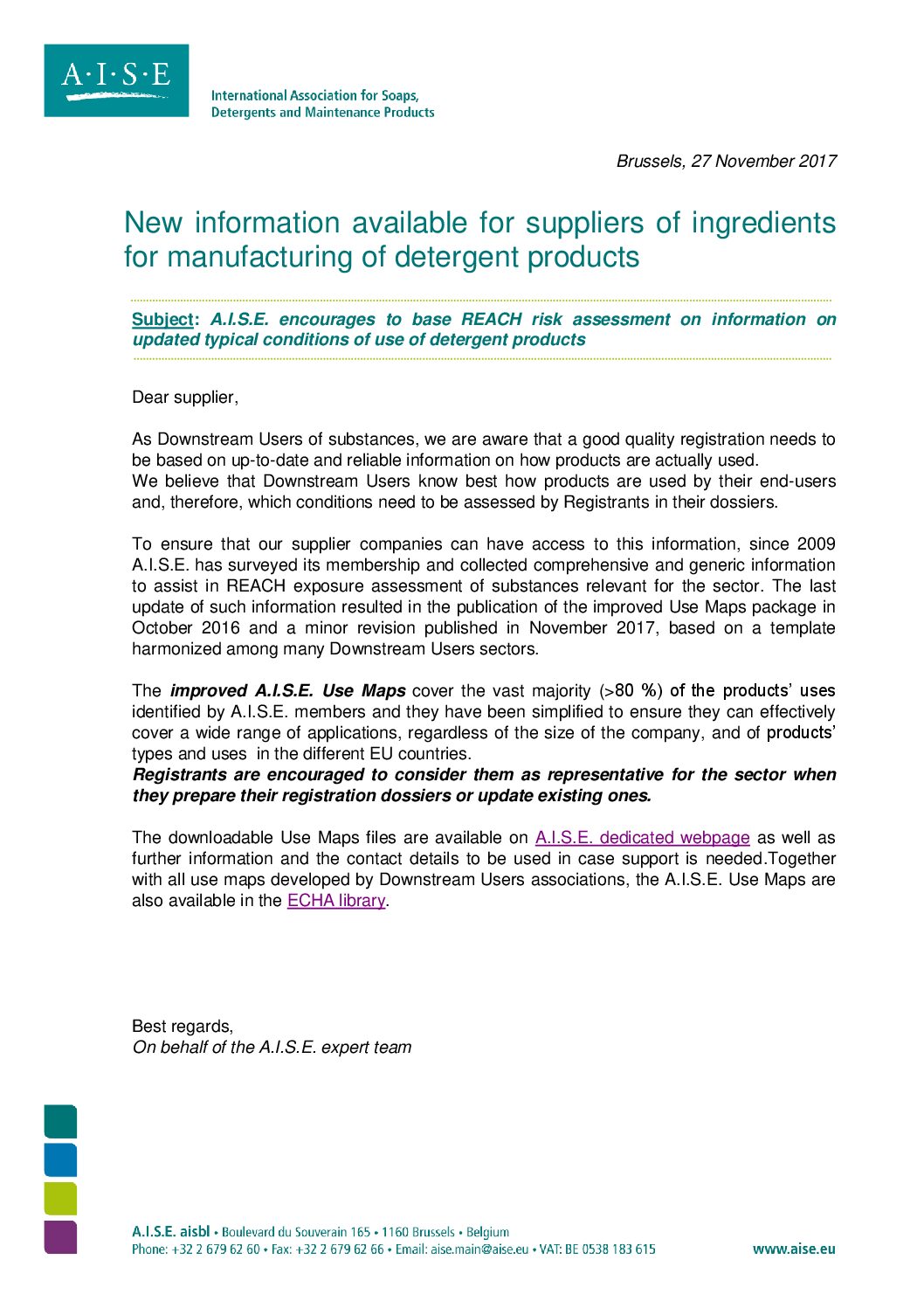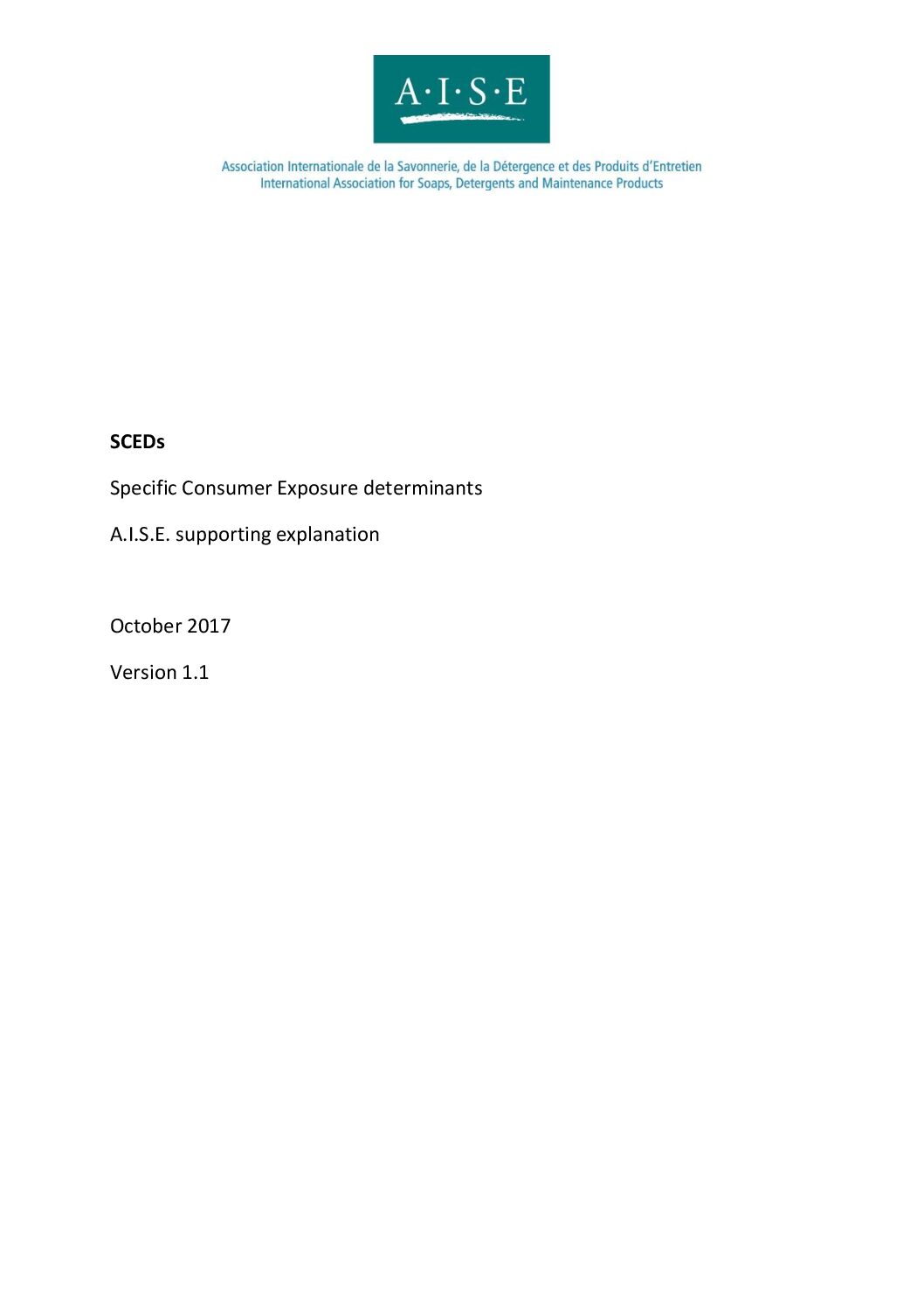REACH Use Maps
A.I.S.E. gathers information from its member companies on all uses of substances in products via use maps. The use maps are packages providing an overview of the common uses in an industry sector throughout the product lifecycle. Each use has a use name and some market information. Additionally, each use consists of contributing activities corresponding to exposure assessment inputs (worker, consumer or environmental exposure). These inputs contain the conditions of use and risk management measures.
A.I.S.E. consolidates and provides this use information to support companies in carrying out exposure assessments to ensure the safe handling of chemicals by all users.
While ECHA provides templates for use maps, A.I.S.E has improved the use maps to include complementary parameters. The use maps are intended to improve the information quality and the communication efficiency within the supply chain by providing information on uses and use conditions directly from downstream users. Therefore, the use maps help registrants to conduct chemical safety assessments which are based on accurate use conditions representing the downstream user industry.
The use maps follow a template established by the ECHA use descriptor system (See ECHA Guidance on Information Requirements and Chemical Safety Assessment, Chapter R.12) and incorporate standard phrases from the eSDSCom catalogue originally developed by Cefic together with DUCC and others.
A.I.S.E. has progressively updated the use maps to consider a wide range of applications by size and specificities of the market in the different EU countries. Currently, the use maps cover the majority (> 80 %) of product uses by small and medium-sized companies.
ECHA publishes A.I.S.E.’s history of the updates to the use map package, which tracks all the changes made to the use maps, such as SCEDs, SWEDs, and SPERCs.
What is eSDScom?
eSDScom is the industry standard for sending safety data sheets, exposure scenarios and all relevant compliance info in the chemical supply chain.
REACH Exposure Assessments
A.I.S.E. has developed relevant information and tools to assist registrants in exposure assessment for substances in their product portfolio. The registrants must assess exposures and characterise risks of hazardous substances to ensure the safety of professional and consumer users who are handling these chemicals in their everyday life.
More specifically, A.I.S.E.’s guidance and tools are passed to suppliers, enabling them to conduct risk assessments, to complete the registration dossiers, demonstrate safe use under the REACH criteria, and to communicate safe use conditions via exposure scenarios (ES) within the supply chain.
A.I.S.E.’s tools and guidance to assist registrants for exposure assessment under REACH in three specific areas are outlined below.
Consumer exposure
Specific Consumer Exposure Determinants (SCEDs) provide detailed information about consumer exposures to substance suppliers so that they can make realistic exposure assessments to communicate via exposure scenarios.
Specifically, the SCEDs consider consumer exposure to cleaning and air care products. These SCEDs are based on information about consumers’ habits and practices gathered from the HERA project, the A.I.S.E. consumer habits surveys and companies’ data. For support, the SCEDs comprise of an explanation document and factsheets for each product.
The Reach Exposure Assessment Consumer Tool (REACT) is developed by A.I.S.E. to enable registrants to estimate systematic consumer exposures to substances in preparations used by consumers. This tool calculates substance exposure through inhalation, dermal, and oral routes as well as the overall exposure.
Download the A.I.S.E. REACT tool and the A.I.S.E. REACT User Manual in the download section below.
Worker exposure
Sector-specific Worker Exposure Descriptions (SWEDs) provide information on the conditions of use of products at industrial sites and by professional workers. SWEDs were initiated by downstream user sector organisations and were then formalised under Action 2.3 of the CSR/ES Roadmap. The SWEDs have inputs linked to the Targeted Risk Assessment Tool by European Centre for Ecotoxicology and Toxicology of Chemicals (ECETOC TRA), its updates, and other models and measured data.
A SWED describes the conditions of use relevant for one or more contributing scenario. For the same activity, e.g. spraying of a product, the use maps could list the different combinations of Risk Management Measures and Operational Conditions that can occur on the market. Conditions of use might differ depending on the hazardous properties of the products. In such cases, different contributing scenarios can be included to fully describe the different options.
To make an efficient use of such information, registrants are encouraged to base their risk assessment on the least stringent controls, e.g. in the absence of risk management measures. If safe use can be demonstrated under these conditions, other conditions of use are considered covered. If safe use cannot be demonstrated, stricter scenarios should be considered and communicated to the downstream users accordingly via the Exposure Scenarios.
For some uses included in the Use Maps Package, no SWED has been developed. In those cases, the assessor is advised to carry out the chemical safety assessment using the default conditions from ECETOC Targeted Risk Assessment Tool for the relevant process category.
Environmental release
Specific Environmental Release Categories, or SPERCs, are sets of sector-specific environmental release values developed for the different activities taking place within A.I.S.E. product’s portfolio.
The concept of SPERCs was improved under Action 2.4 of the CSR/ES Roadmap and is in line with ECHA’s Guidance on Information Requirements/Chemical Safety Assessment. SPERC values correspond to levels of a substance released into the environment during use. They depend on a number of factors explained in the SPERC documents. For a description of environmental scenarios linked to uses of cleaning and maintenance products visit the section on uses. The A.I.S.E. factsheets made available here are referred to in the use maps through their code included as the ‘Exposure Assessment input’.
SPERC factsheets and CHESAR SPERC files, addressing comments received after the first REACH registration deadline, are available below. Improvements include greater consistency across sectors and more robust justifications for the data.
A.I.S.E. strongly encourages registrants preparing their chemical safety assessment and downstream users preparing their own downstream assessment to use these revised SPERCs going forward.
What is Chesar?
Chesar is ECHA’s Chemical Safety Assessment and Reporting Tool for companies carrying out chemical safety assessments and preparing chemical safety reports and exposure scenarios for supply chain communication.







